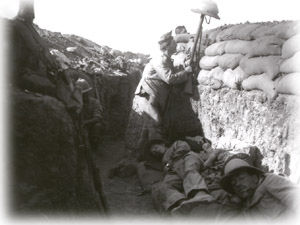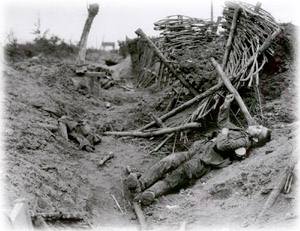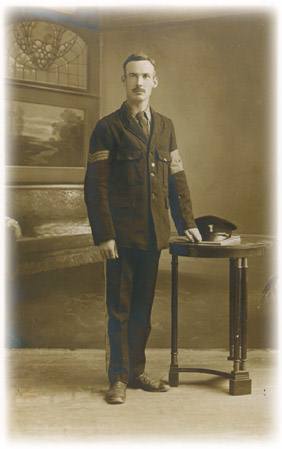The Great War introduced weapons either newly invented or not used before on such a large scale including: barbed wire, machine guns, heavy artillery shells, planes, tanks and possibly most fearsome, chemical warfare – poison gas. In the motor age, it is easy to forget that Cavalry regiments did battle and horses and donkeys were widely used for transporting goods, pulling ambulances and artillery, etc. In the early days of the war, the British army had a great deal of difficulty getting both troops and supplies to where they were needed.

Life in the trenches. A soldier raises a helmet over the edge of a trench to see if it will draw enemy fire.
Throughout the war, men in the trenches were not relieved as quickly as they should have been and many were literally at the front-line for several weeks without respite and often without adequate supplies. Rat infestation was common in the trenches and those which gorged on the bodies of gassed soldiers, were also crazed with poison. An extremely unpleasant nuisance, the vermin also spread disease.
Dead and wounded had to be carried by stretcher-bearers or comrades from the battlefield and through the trenches. For every man killed, several more were wounded. Field treatment was limited to a dressing and some morphine, regimental aid posts often being located in shell-holes or in a trench. Seriously wounded soldiers would be moved to an Advanced Dressing Station a few miles from the front but they often had to wait hours for the cover of darkness to attempt the journey.

A German soldier killed in battle.
Those who survived were transferred to Casualty Clearing Stations or Stationary Hospitals until they could either be returned to the front or evacuated (often by Hospital ship) to a military hospital in the UK. Many women actively participated in the war in the medical services. A great many others did voluntary work at home, fundraising or manufacturing supplies.
Soldiers writing home tried to reassure their families and would not have written much about the horrors they experienced – their letters were also censored. At such a distance from the battlefields and with government propaganda releasing only approved information, the Irish people had little exposure to the realities of the war. However, U-boat attacks on shipping did result in several ships being wrecked close to the Irish coast and with bodies being washed onto beaches, Irish civilians did experience just a little of the Great War at home.
Irish Women In The War
Nationalist and Unionist politicians alike, did not plan on including women in the electorate. Suffragettes protested for franchise rights for women at Home Rule meetings. Northern and Southern women who wished to stand by their men found themselves excluded and formed their own organizations such as the Ulster Women’s Unionist Council, the Irish Women’s Franchise League and an auxiliary unit to the Irish Volunteers, Cumann na mBán.

Lance Sergeant William O’Reilly captured in 1914.
Women became involved in the recruiting committee for the Royal Dublin Fusiliers, not only assisting in recruitment, but organizing for the comfort-fund (sourcing cardigans, gloves, pipes and tobacco for new recruits and Prisoners-of-War).
Many women did voluntary work making dressings, bandages and surgical supplies. Others joined Voluntary Aid Detachments or VADs, and served in field hospitals in Europe and at home. The British Red Cross Society was predominantly female, though many men also did voluntary non-combat work.
Click here to download more about this
At Sea
Ireland was distant enough from the battlefields for the public to be somewhat removed from the horrors of war. In previous conflicts, hitting civilian targets was, by and large, considered bad form. This war was different. German U-boats began to attack any vessel, ‘flying the British flag or a flag of her allies’. This quote appeared in newspaper advertisements warning travellers that they sailed on British ships at their peril. The ad was placed by the German embassy in the U.S. and appeared alongside an advert for the Lusitania. The Lusitania was torpedoed by a U-boat off the Old Head of Kinsale and 1,198 men, women and children were lost (including Sir Hugh Lane, the famous art collector); many were buried in Co. Cork where their bodies were brought ashore.
Just a month before the war ended, the R.M.S. Leinster, a City of Dublin Steam Packet Company ship, was torpedoed having left Kingstown (Dún Laoghaire). 501 of the 771 people on board died, including crew, postal workers, civilians, Voluntary Aid nurses and eight Royal Dublin Fusiliers.